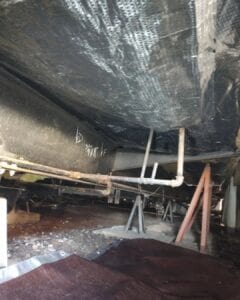Mobile Home Belly Wrap Emergency Repair
Don't Let Belly Wrap Damage Cost You $15,000+ in Structural Repairs
🔗 Related: Crawl Space Encapsulation | Water Leak Detection
Emergency Belly Wrap Repair Materials
Professional-grade materials shipped direct - no hunting at multiple stores for hard-to-find supplies

Heavy-Duty Belly Wrap Plastic
Professional-grade 6-20 mil polyethylene specifically designed for mobile home underbelly protection. Ships direct - no more hunting at stores!
- 6-20 mil thickness options
- UV and puncture resistant
- Designed for mobile home flex
- White color for easy inspection
- Covers 1,000-4,000 sq ft
- Fast shipping to your door
Professional Seaming Tape
Heavy-duty butyl tape for permanent belly wrap seams. Often impossible to find locally - order online for guaranteed delivery.
- Butyl adhesive technology
- Permanent weatherproof seal
- Works in all temperatures
- UV and chemical resistant
- Professional contractor grade
- Hard-to-find locally
Mobile Home Insulation
Fiberglass batts and foam board insulation designed for mobile home underbelly applications. Essential for energy efficiency and comfort.
- R-11 to R-19 options
- Moisture-resistant facing
- Easy installation
- Fits standard joist spacing
- Energy Star compliant
- Ships direct to your door
Installation Tool Kit
Complete tool kit with staple gun, utility knives, measuring tools, and fasteners. Everything needed for professional installation.
- Heavy-duty staple gun
- Professional utility knives
- 25ft tape measure
- Stainless steel staples
- Safety equipment
- Ships complete kit
Emergency Patch Kit
Quick-fix patches for emergency belly wrap repairs. Buy time while ordering permanent replacement materials.
- Self-adhesive patches
- Multiple sizes included
- Weather-resistant
- Temporary to permanent fix
- Easy application
- Emergency preparedness
Moisture Detection System
Professional moisture meters for detecting problems before they become expensive. Essential for belly wrap maintenance.
- Digital moisture readings
- Pin and pinless operation
- Works on wood and plastic
- LED alerts
- Data logging
- Prevents costly damage
Belly Wrap Damage Assessment Guide
30+ years of mobile home experience - identify problems before they become disasters
🔍 Visual Inspection Signs
- • Sagging or torn belly wrap material
- • Visible holes or punctures
- • Discolored or stained areas
- • Material pulling away from frame
- • Insulation hanging down or missing
🏠 Interior Warning Signs
- • Soft spots in flooring
- • Unusual odors or musty smells
- • Higher than normal energy bills
- • Cold floors in winter
- • Signs of pest intrusion
⚠️ Emergency Situations
- • Water leak under mobile home from plumbing failures
- • Storm damage or impact tears
- • Rodent damage to material
- • Complete material failure
- • Structural settling damage
Professional Installation Process
Step-by-step guide using contractor techniques - save thousands on labor costs
Damage Assessment & Cleanup
Safety First: Turn off utilities and assess structural damage. Remove all damaged material and clean the area thoroughly.
Tools Needed: Safety equipment, utility knife, moisture meter, flashlight.
Pro Tip: Document damage with photos for insurance claims before starting repairs.
Structural Repairs
Foundation Work: Check and repair piers, footers, and leveling shims. Address any structural issues before installing new belly wrap.
Critical Step: Ensure mobile home is level and properly supported before proceeding.
Materials: According to the HUD guidelines, proper support is essential. The EPA also emphasizes proper moisture control for indoor air quality.
Insulation Installation
Energy Efficiency: Install proper insulation between floor joists before belly wrap installation. The Department of Energy recommends proper underbelly insulation for mobile homes.
Technique: Use faced insulation with vapor barrier facing up toward living space.
R-Value: Minimum R-11, R-19 recommended for most climates.
Belly Wrap Installation
Professional Method: Start at one end, pull tight, and staple every 6-8 inches. Overlap seams by 6 inches minimum.
Critical Details: Use heavy-duty staples and seal all seams with professional tape.
Quality Check: Ensure material is taut with no sagging or loose areas.
Sealing & Weatherproofing
Permanent Protection: Seal all seams, edges, and penetrations with professional-grade tape and sealants.
Attention to Detail: Every gap is a potential entry point for moisture and pests.
Final Step: Install proper ventilation if required by local codes.
Quality Inspection
Professional Standards: Complete visual inspection, test for air leaks, and document completion.
Maintenance Plan: Schedule annual inspections and address minor issues promptly.
Integration: Consider full encapsulation for maximum protection.
🚫 Avoid These Costly Mistakes
Common errors that lead to thousands in additional damage
🚫 Using Thin Materials
6-mil minimum thickness required - thinner materials fail quickly in mobile home applications
🚫 Poor Seam Sealing
Gaps allow moisture and pests - use professional tape on all seams and overlaps
🚫 Ignoring Structural Issues
Fix foundation problems first - belly wrap over damaged structure will fail again
🚫 Skipping Insulation
Belly wrap without insulation wastes energy and reduces effectiveness significantly
Mobile Home Belly Wrap FAQ
Extensive Belly Wrap Damage?
When repair costs exceed home value, get a fair cash offer for your mobile home in any condition
✓ 30+ Years Experience ✓ Any Condition ✓ Fast Closing ✓ Zero Fees

